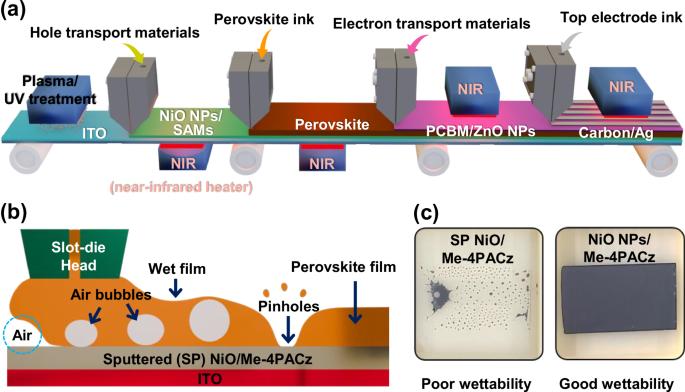Influence of interfacial roughness on slot-die coatings for scaling-up high-performance perovskite solar cells
IF 9.6
Q1 MATERIALS SCIENCE, MULTIDISCIPLINARY
引用次数: 0
Abstract
Slot-die coating (SDC) technology is a potential approach to mass produce large-area, high-performance perovskite solar cells (PSCs) at low cost. However, when the interface in contact with the perovskite ink has low wettability, the SDC cannot form a uniform pinhole-free perovskite film, which reduces the performance of the PSC. To address this issue, in this study, the wettability of the hole transport layer (HTL) interface was investigated in depth by analyzing the variation of wettability with process and its correlation with the roughness of the HTL interface. As a result, it was found that SDC could increase the roughness of the HTL interface to improve wettability and form a uniform high-quality perovskite layer without pinholes, and furthermore, SDC-based NiOx/Me-4PACz HTL suppressed energy losses at the HTL/perovskite interface. In addition, a unit cell achieved 19.17% of efficiency with long-term stability and lab cell-sized modules showed up to 17.42%. Slot-die coating is promising for the large-scale and low-cost manufacture of perovskite solar cells. Here, the effect of wettability of the hole transport layer is investigated, finding that increased surface roughness improves wettability and prevents pinhole formation, favoring solar cell efficiency.

界面粗糙度对用于放大高性能过氧化物太阳能电池的槽栅涂层的影响
槽栅镀膜(SDC)技术是一种以低成本大规模生产大面积、高性能包晶体太阳能电池(PSC)的潜在方法。然而,当与包晶墨水接触的界面润湿性较低时,SDC 无法形成均匀无针孔的包晶薄膜,从而降低了 PSC 的性能。针对这一问题,本研究通过分析润湿性随工艺的变化及其与孔传输层(HTL)界面粗糙度的相关性,深入研究了孔传输层(HTL)界面的润湿性。结果发现,SDC 可以增加 HTL 界面的粗糙度,从而改善润湿性并形成均匀、无针孔的高质量过氧化物层,此外,基于 SDC 的 NiOx/Me-4PACz HTL 还能抑制 HTL/ 过氧化物界面的能量损失。此外,一个单元电池的效率达到了 19.17%,并具有长期稳定性,而实验室电池大小的模块效率则高达 17.42%。槽模镀膜技术有望大规模、低成本地制造过氧化物太阳能电池。本文研究了空穴传输层润湿性的影响,发现增加表面粗糙度可改善润湿性,防止针孔形成,从而提高太阳能电池的效率。
本文章由计算机程序翻译,如有差异,请以英文原文为准。
求助全文
约1分钟内获得全文
求助全文
来源期刊

Communications Materials
MATERIALS SCIENCE, MULTIDISCIPLINARY-
CiteScore
12.10
自引率
1.30%
发文量
85
审稿时长
17 weeks
期刊介绍:
Communications Materials, a selective open access journal within Nature Portfolio, is dedicated to publishing top-tier research, reviews, and commentary across all facets of materials science. The journal showcases significant advancements in specialized research areas, encompassing both fundamental and applied studies. Serving as an open access option for materials sciences, Communications Materials applies less stringent criteria for impact and significance compared to Nature-branded journals, including Nature Communications.
 求助内容:
求助内容: 应助结果提醒方式:
应助结果提醒方式:


